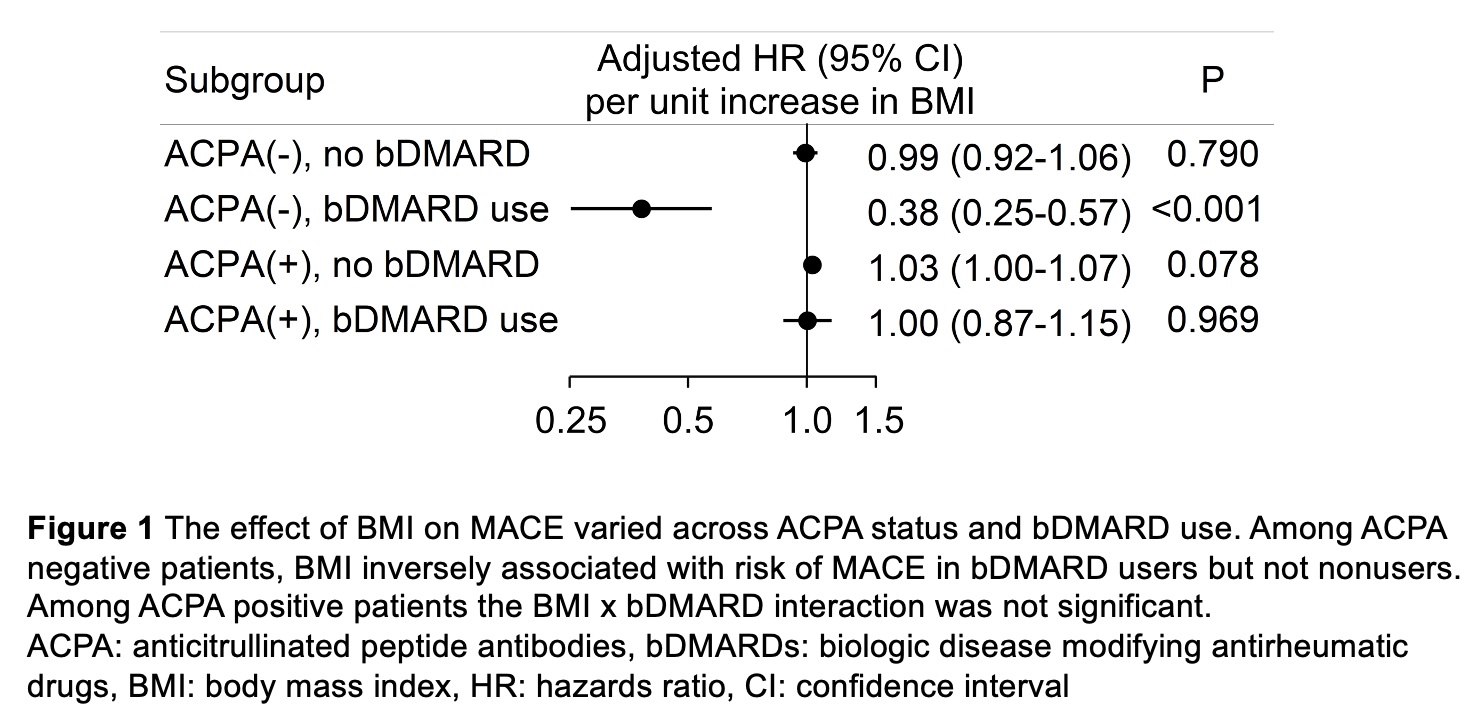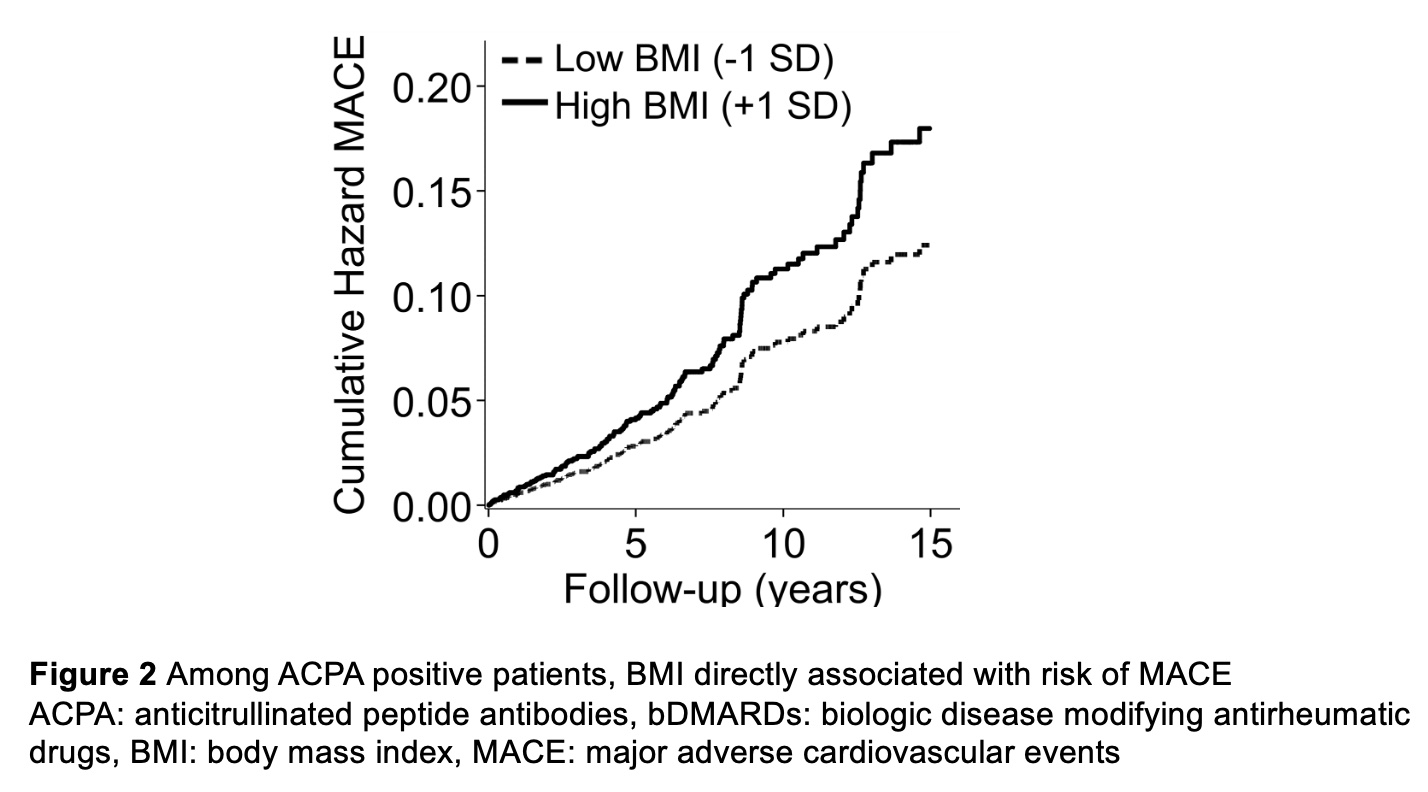Session Information
Session Type: Abstract Session
Session Time: 3:00PM-4:30PM
Background/Purpose: The impact of body mass index (BMI) as a surrogate of body fat content on cardiovascular (CV) risk in rheumatoid arthritis (RA) is unclear. Obesity associated with higher RA activity among anticitrullinated antibody (ACPA) positive but not negative patients. Since RA activity predicted CV risk, we hypothesized that obesity may associate with such risk differently in ACPA positive versus negative patients. Biologic disease modifying antirheumatic drugs (bDMARDs) control inflammation, mitigate CV risk and may alter body composition in RA. We posited that BMI may influence CV risk differently in bDMARD users versus nonusers. Lastly, ACPA status influenced effectiveness of certain bDMARDs. We therefore evaluated the association of BMI with CV risk in RA and whether this relationship varied across ACPA status and bDMARD use.
Methods: We studied 3646 RA patients free of CV disease upon registration to an International consortium. Main outcome was incident major adverse CV events (MACE) encompassing non-fatal myocardial infarction, non-fatal stroke, or CV death. Missing data were imputed using multiple imputation with 10 repetitions. Multivariable Cox models stratified by center risk evaluated the impact of body mass index (BMI), ACPA positivity, bDMARD use, as well as the two and three way interactions of BMI with ACPA positivity and/or bDMARD use on risk of MACE after adjusting for age, gender, diabetes, hypertension, family history of CV disease, smoking, total cholesterol to high-density lipoprotein cholesterol ratio, 28-joint disease activity score with ESR, and RA duration.
Results: Throughout 21,061 patient years, 170 first MACE events were recorded. After multivariable adjustment, the main effects of BMI (HR 1.02, 95% CI 0.98-1.05, p=0.343) and bDMARD use (HR 1.49, 95% CI 0.75-2.96, p=0.251) on MACE risk were not significant, while ACPA positivity was (HR 1.45, 95% CI 1.03-2.05, p=0.036). This was qualified by a significant three way interaction between BMI, bDMARD use and ACPA (p-interaction< 0.001), indicating that the effect of BMI on MACE varied across ACPA status and bDMARD use. In ACPA negative patients, the bDMARD × BMI interaction was significant (p< 0.001) such that BMI inversely associated with risk of MACE in bDMARD users (HR 0.38, 95% CI 0.25-0.57, p< 0.001) but not nonusers (HR 0.99, 95% CI 0.92-1.06, p=0.790, Figure 1). In ACPA positive, while the bDMARD ×BMI interaction (p=0.689) and bDMARD main effect (HR 1.27, 95% CI 0.60-2.68, p=0.528) were not significant, there was a main effect of BMI on MACE (HR 1.04, 95% CI 1.01-1.07, p=0.038, Figure 2). Considering the interaction between ACPA and BMI stratified by bDMARD use, ACPAs modified the effect of BMI on MACE risk in bDMARD users (p-interaction< 0.001). Among users, BMI associated with MACE in ACPA negative (as above) but not positive patients (HR 1.00, 95% CI 0.87-1.15, p=0.969). In bDMARD nonusers, the ACPA × BMI interaction (p=0.117), BMI (HR 1.02, 95% CI 0.99-1.05, p=0.178), and ACPA main effects (1.41, 95% CI 0.99-2.02, p=0.059) were not significant.
Conclusion: Higher BMI predicated greater MACE risk in ACPA positive patients; in ACPA negative, BMI was inversely associated with risk of MACE only among bDMARD users.
ACPA: anticitrullinated peptide antibodies, bDMARDs: biologic disease modifying antirheumatic drugs, BMI: body mass index, HR: hazards ratio, CI: confidence interval
ACPA: anticitrullinated peptide antibodies, bDMARDs: biologic disease modifying antirheumatic drugs, BMI: body mass index, MACE: major adverse cardiovascular events
To cite this abstract in AMA style:
Karpouzas G, Myasoedova E, Gonzalez-Gay M, Corrales-Martínez a, Rantapaa-Dahlqvist S, Sfikakis P, Dessein P, Tsang L, Hitchon C, El Gabalawy H, Pascual Ramos V, Contreras Yanez I, Colunga Pedraza I, Galarza-Delgado D, Azpiri-Lopez j, Semb A, Van RIel P, Misra D, Durez P, Bridal Logstrup B, Hauge E, Kitas G, Ormseth S. The Impact of Body Mass Index on Cardiovascular Risk in Rheumatoid Arthritis Varies Across Anticitrullinated Protein Antibody Status and Biologic Use [abstract]. Arthritis Rheumatol. 2024; 76 (suppl 9). https://acrabstracts.org/abstract/the-impact-of-body-mass-index-on-cardiovascular-risk-in-rheumatoid-arthritis-varies-across-anticitrullinated-protein-antibody-status-and-biologic-use/. Accessed .« Back to ACR Convergence 2024
ACR Meeting Abstracts - https://acrabstracts.org/abstract/the-impact-of-body-mass-index-on-cardiovascular-risk-in-rheumatoid-arthritis-varies-across-anticitrullinated-protein-antibody-status-and-biologic-use/


